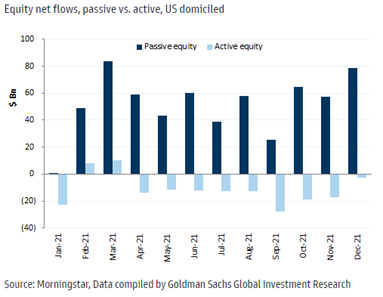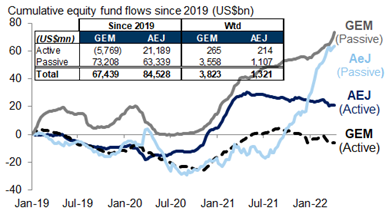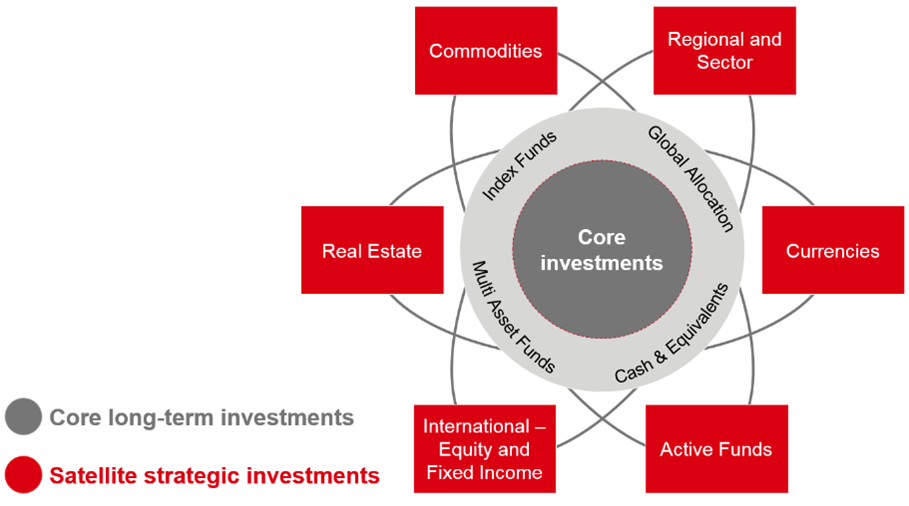Investing has come a long way in the last 50 years, pioneered by an increase in access to information and access to trading platforms.
There is an increase in assets available to investors and a decrease in the barriers to entry leading to an increase in trading volume.
The amount of information and the timing of which investors receive this information has improved significantly, allowing this information to be processed by the markets faster.
Some believe that this has increased the efficiency of the market, which would favour passive investing.
The first chart shows the net flows of equity between passive and active in the US.

Fig 2 shows the trend in active and passive investing for global emerging markets (GEM) and Asia ex Japan (AEJ).

Source: EFPR
Both charts show the increased popularity of passive investing over the past few years.
What is passive investing?
Passive investing is a long-term approach that aims to minimise buying and selling in order to decrease fees and rather takes the return of the market.
This is usually done through investing in index funds which tracks the return of the index that it follows. For example, the S&P/ASX 200 measures the performance of the largest 200 stocks on the ASX.
In contrast, an active investor aims to beat the market and so will buy stocks they think are undervalued and sell those that are overvalued.
Passive investors do not argue that active investors may beat the market in the short run but question the ability to consistently achieve this in the long run.
Passive investing is growing in favour with those who do not have the time or expertise to actively manage a portfolio of assets.
There are multiple debates about these two approaches with both having strong points for and against. Arguably the biggest point of contention arises over the deemed level of market efficiency.
Efficient Market Hypothesis
The efficient market hypothesis is a hypothesis in finance that states that share markets reflect all available information and price stocks accordingly. This means that investors should not be able to outperform the market in the long run.
If the market is efficient then there would be no benefit to active investing. Passive investors would achieve a higher return in the long run due to lower costs.
This is referred to as a hypothesis or theory as it is constantly being debated. It is not considered a yes or no answer, but rather a question of the degree of efficiency.
The three levels of market efficiency are:
- Weak form efficiency – market prices reflect all past information.
- Semi-strong form – stocks reflect all publicly available information and investors can’t achieve abnormal returns.
- Strong-form – prices reflect all public and private information.
Can these approaches be used together?
These two approaches do not need to be mutually exclusive and can be used in unison to reap the benefits from both.
One such approach is the core-satellite portfolio model. This involves building a portfolio that uses index funds as the core of the portfolio (passive investment) and smaller positions in active investments, referred to as the satellites.

Source: www.assetmanagement.hsbc.com.hk
One of the benefits of having passive index funds as the core is that they are a low-cost way to track the return of the market.
ETF’s can be a useful way to implement these. Some of these are BetaShares Australia 200 ETF (A200), Vanguard S&P 500 ETF (VOO) and Invesco NSADAQ 100 ETF (QQQM).
The purpose of the satellites is to focus on sectors or stocks that you expect to outperform the market. This can be done either through sector focused ETFs or single stock selection.
The benefits of this approach is to create a cost affective solution with the aim of generating higher returns than the market benchmark, whilst aiming to reduce volatility of these returns.
Whilst there is great debate on the efficient market hypothesis, most academics agree that it falls somewhere between weak form and strong form.
There is no clear answer to whether active or passive investing is a better approach as it depends on the investor, their risk profile, their investment expertise, and the level of returns they aim to achieve.
There are upsides to both approaches and the increased number and variety of ETFs has increased the ease of implementing a combination of passive and active investing.
The views expressed in this article are the views of the stated author as at the date published and are subject to change based on markets and other conditions. Past performance is not a reliable indicator of future performance. Mason Stevens is only providing general advice in providing this information. You should consider this information, along with all your other investments and strategies when assessing the appropriateness of the information to your individual circumstances. Mason Stevens and its associates and their respective directors and other staff each declare that they may hold interests in securities and/or earn fees or other benefits from transactions arising as a result of information contained in this article.



